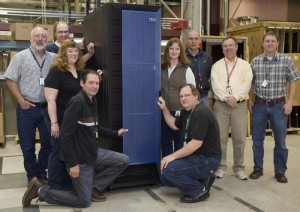
IBM has expanded its PureSystems line of pre-integrated systems to include new models to handle business analysis and online transaction processing.
The PureData systems have been assembled to excel at three common tasks within enterprise computing: business intelligence, near real-time data analysis and online transactional processing.
Each of these systems is “built to a particular application’s purpose. They are integrated by design. It’s not just a bundle of technology being pulled together,” said Phil Francisco, IBM Vice President of big data product management. The systems have been designed so they can be quickly installed and easily maintained.
IBM is not alone in offering pre-integrated systems for heavy workloads. Last week, Oracle introduced the latest version of its Exadata system, designed for similarly intensive workloads.
“We have a far different approach,” than Oracle, said Pete McCaffrey, IBM’s Director of PureSystems marketing. Oracle has “a one-size-fits-all approach; we’re optimising for the specific type of data workload. That is why we are coming out with different models aligned to different workloads.”
IBM designed one of the systems, PureData System for Transactions, for credit card processing and other fast-paced transactional duties in retail operations and financial services. These systems were designed to handle “high integrity and high scalability” workloads, Francisco said. This system has been designed for high performance, using a shared data clustered architecture.
Another system, PureData System for Analytics, is capable of processing large amounts of data — in the order of billions of records, or petabytes of data. This system includes the company’s Netezza data warehousing technology, as well as a library of analytic functions.
The third system, PureData System for Operational Analytics, can be used to aid decision making using data as soon as it comes across the wire. It can provide analytical summaries for as many as 1,000 business operations at once. An organisation could use such a system for fraud detection, for instance, or to track rapid fluctuations in supply-and-demand cycles.
In contrast to the transaction focused systems, both of the analysis systems are configured for massively parallel processing, Francisco said.
IBM engineered these systems so that the components work optimally for each type of workload, lessening the amount of work that in-house designers would have to make if they wanted to build such systems in-house, the company claimed. For instance, the storage subsystems have been designed so that more frequently consulted data migrates to faster flash storage. The transaction system can automatically spin up more copies of an application server should workloads spike. The company also uses a number of application patterns, or architectural blueprints, that capture best practices of how to embed applications onto the hardware platform.
Each of these systems can be operational in as little as a few hours, Francisco said.
IBM introduced the PureSystems line of integrated hardware systems in April, which are pre-packaged combinations of IBM hardware and software configured for specific tasks. Previous releases include the PureFlex and PureApplication systems.
PureData Systems will be available by the end of October. The price of the PureData Systems varies by configuration, but starts at about US$500,000.





